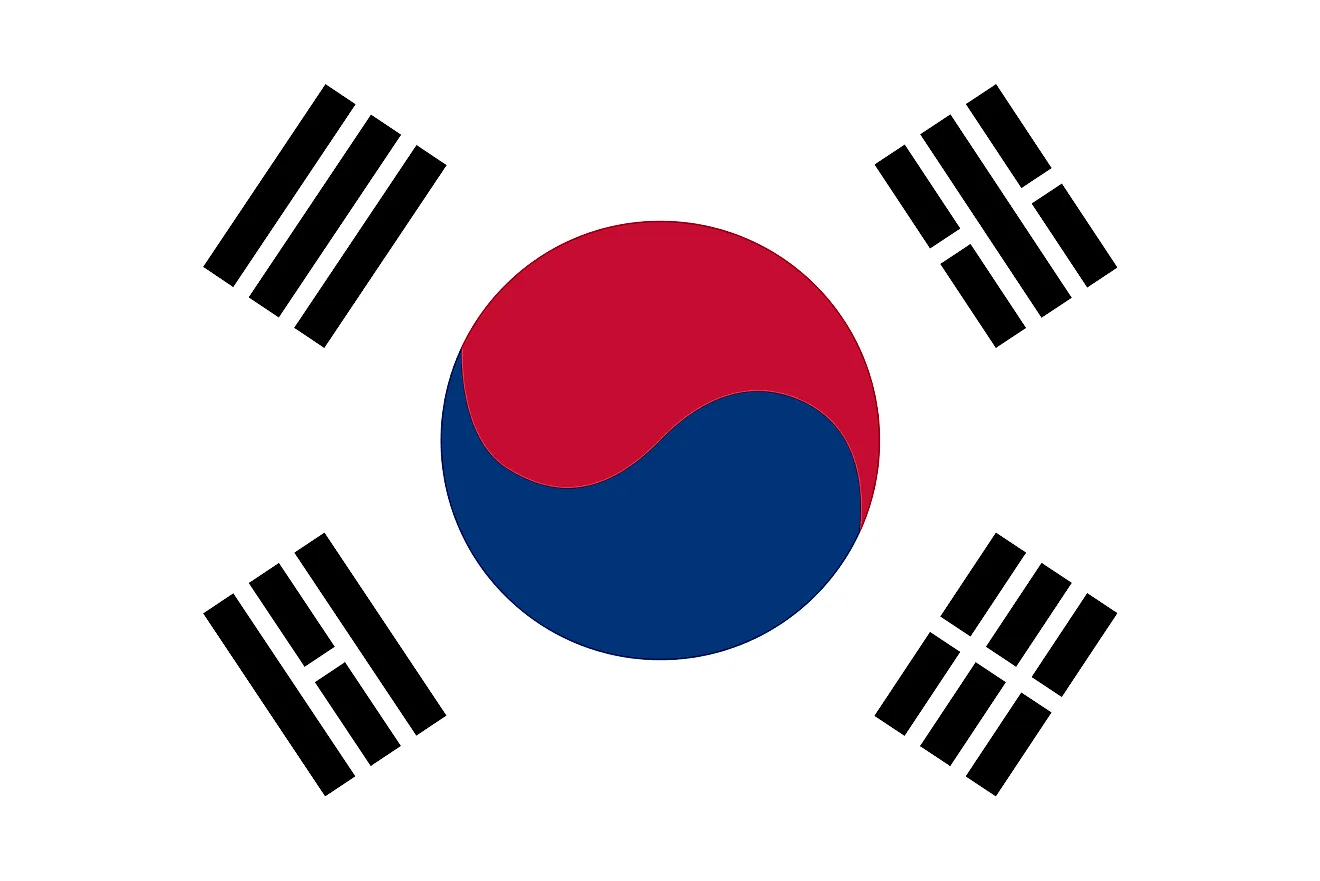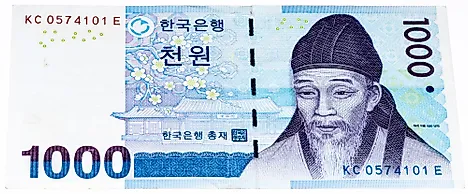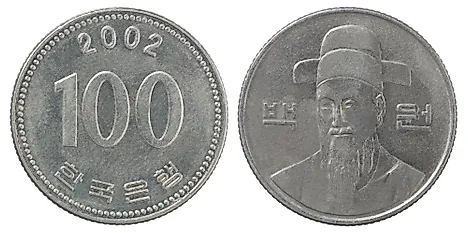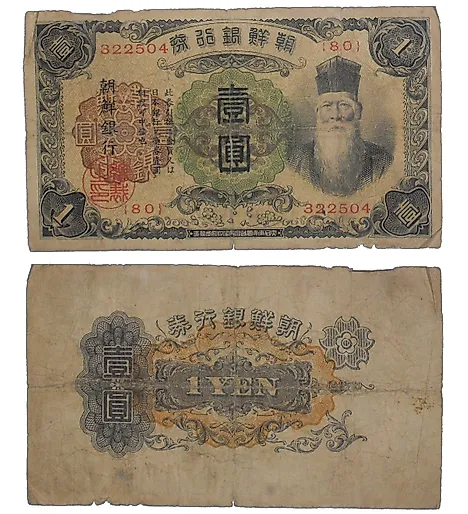Flags, Symbols, & Currencies of South Korea

Although flag of South Korea was officially adopted on October 15, 1949, it had been in use as early as 1800s. The flag has three main parts; a white background, Taeguk, and trigram. A Taeguk (red and blue disc) is located at the center of the flag. Each corner of the flag also features a black trigram, making it four trigrams on the flag. The national flag has a height to length proportion of 2:3.
White is one of the traditional colors in the culture of South Korea. It represents purity and peace. In the 19th century, Koreans wore a white-colored traditional daily attire and included the tradition on their flag. The Taeguk, a red (top) and blue yin-yang symbol at the center, symbolizes the balance of the universe, a concept that is based on the traditional um-yang philosophy of the region. The red and the blue halves of the Taeguk represents the positive cosmic and the negative cosmic forces, respectively. The trigrams together symbolize harmony and movement with each of the trigrams representing the various classical elements.The three black unbroken bars (upper left) symbolize heaven, the trigram (lower left) symbolizes fire, the trigram (upper right) symbolizes water, and the three broken bars (lower right) symbolize earth.
History of the Flag
For a long period of time, Korea did not have any national flag. However in 1876, during the signing of the Japan-Korea treaty, Korea first faced the issue of the absence of a national flag as Japan displayed one of its own during this time. However, a flag was not immediately adopted. For several years, discussions related to the flag took place. Finally, in 1883, the Taegukgi, the flag of Korea, was officially adopted. It had a ying-yang symbol at the center and four trigrams surrounding it. This flag remained in use even after the annexation of the peninsula by Japan. Following World War II and the division of the Korean Peninsula into two zones, the Taegukgi remained in use in both the zones. However, a few years later, North Korea adopted a new design for its flag. South Korea, on the other hand, continued to use the Taegukgi and officially adopted it on October 15, 1949.
Symbols of South Korea
National Coat of Arms of South Korea

Nara Munjang, the National Emblem of the Republic of Korea, is mainly used for matters such as official documents, public ID cards, and government vessels. The emblem draws inspiration from the official flag of the Republic of Korea as well as the national flower. It features the taeguk symbol (from the national flag) surrounded by five flower petals and a ribbon displaying the name of the country in Hangul characters.
National Anthem
- Anthem Title: Aegukga (The Patriotic Song)
- Music composer: Eak-tai
- Lyricist: Unknown
- Date of Adoption: 1948
Aegukga (Love Country Song) is South Korea's national anthem. The anthem's lyrics were written in 1896 by an unknown author and set to music by Ahn Eak-tai in 1936. It was officially adopted as the national anthem in 1948, when South Korea was founded. Although the lyrics were set to music in the 1930s, they were arranged in 2018. Of the anthem's four verses, only the first verse and the chorus are often sung during public events.
Aegukga
동해 물과 백두산
이 마르고 닳도록,
하느님이 보우하
사 우리나라 만세.
후렴:
무궁화 삼천리 화
려 강산,
대한 사람, 대한으
로 길이 보전하세.
남산 위에 저 소나
무 철갑을 두른 듯
바람서리 불변함
은 우리 기상일세.
후렴
가을 하늘 공활한
데 높고 구름 없이
밝은 달은 우리 가
슴 일편단심일세.
후렴
이 기상과 이 맘으
로 충성을 다하여
괴로우나 즐거우
나 나라 사랑하세.
후렴
Love Country Song
Until that day when Mt. Baekdu is worn
away and the East Sea's waters run dry,
May God protect and preserve our country.
Refrain:
Roses of Sharon and three thousand Ri
full of splendid mountains and rivers;
Great Koreans, to the Great Korean way,
always stay true.
As the pine atop Namsan Peak stands firm,
unchanged through wind and frost,
as if wrapped in armour, so shall our
resilient spirit.
Refrain
The autumn skies are void and vast, high
and cloudless;
the bright moon is like our heart, undivided
and true.
Refrain
With this spirit and this mind, let us give all
loyalty,
in suffering or joy, to love our nation.
Refrain
The Currency of South Korea is the South Korean won
The country’s experience in developing infrastructure and better living conditions saw it transform to a dynamic economy. The country depends heavily on international trade and therefore needs a stable currency that fluctuates less and sustains a favorable balance of payment. Its official currency is the Korean Republic Won.
The won (symbol: ₩; code: KRW) is the official currency of South Korea. It is divided into 100 jeon (cents). Jeon are not used for everyday transactions within Korea but are limited to currency exchange and international trade. The Bank of Korea is responsible for issuing the won; it should be noted that the South Korean Won is different from the North Korean Won used in North Korea. The Bank of Korea reserves all the rights to produce the won. The currency is annually released to commercial banks around the Korean holidays of Seollal and Chuseok.
South Korean won Coins and Banknotes
The coins in circulation in South Kora are the ₩1, ₩5, ₩10, ₩50, ₩100, and the ₩500. The ₩1 and ₩5 are rarely used in circulation because the prices of goods have been rounded to the nearest 10 won. The notes in circulation in South Korea are in denominations of ₩1000, ₩5,000, ₩10,000, and ₩50,000. Several modifications have been done on the banknotes including the introduction of sophisticated security features. The government plans to scrap off the use of coins by 2020 as the economy shift from physical to digital currency. As of July 18th 2017, the won exchange rate was 1,123.96KRW = 1 USD.
Historical Currencies of South Korea
Before the split of the Koreas, the currency used was the Korean Yen which was a cognate of the Japanese yen and the Chinese Yuan. After the split in 1945, both countries adopted the won which had equal value to the yen. The South Korean Won was pegged to the dollar at a fixed rate of 15 won = 1 US dollar. After the Korean War, the South Korean won was devalued severally, and in April 1951, the won had lost value to trade at 6000 won = 1 US dollar. In February 1953 the won was replaced with the Hwan at a rate of 100 won = 1 Hwan. In June 1962 the won was reintroduced at a rate of 1 won = 10 Hwan and was pegged at 125 won = $US 1. By January 1980 the peg had devalued to trade at a rate of 580 won = 1 US dollar. In 1980, Korea initiated plans to establish a floating exchange rate and in 1997 after signing an agreement with the International Monetary Fund, it was allowed to float. This was a move that saw the won devalued by half.














